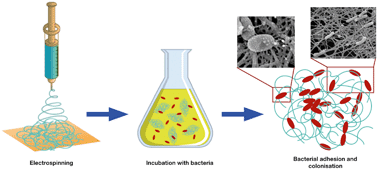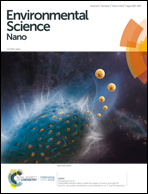A study on the dependence of bacteria adhesion on the polymer nanofibre diameter
Abstract
Topography nanostructures have been extensively studied to reduce bacterial adhesion in medical, food and industrial contexts. Fibres have also been used in energy, water and wastewater treatments, and medical applications. Nanosized fibres, however, have rarely been analysed in interactions with bacteria, and they have always been found to inhibit bacterial adhesion and proliferation. We discussed here the size effect of polymer nanofibres on the attachment of bacteria. As a model system, a 3D self-standing electrospun nanofibrous poly(ε-caprolactone)-based scaffold was fabricated, and Burkholderia terricola bacteria cells were used for testing the interactions. The initial reversible adhesion and the subsequent stable irreversible docking of bacteria to nanofibres through various mechanisms, the orientation of bacteria along nanofibres, and the communication between cells were explored. Bacteria initially attached preferentially to nanofibres with ≈100 nm diameter, i.e. an order of magnitude smaller than that of the bacteria, resulting in a bacteria-to-nanofibre diameter ratio as large as ≈5. It is worth noting that interactions always occurred between bacteria and nanofibres coated with a conditioning film of organic substances of bacterial origin. The conditioning film, the outer membrane vesicles and the bacterial appendages were found to play a remarkable role in facilitating the subsequent adhesion of B. terricola cells to the electrospun poly(ε-caprolactone) nanofibres. They also permitted bacteria to reversibly and then stably attach to the nanofibrous material and connect and communicate with each other to form microcolonies embedded in exopolymeric substances, as an early step towards future biofilm formation. No inhibiting effect of the nanosized fibres on the adhesion, proliferation and vitality of the bacterial cells was observed.



 Please wait while we load your content...
Please wait while we load your content...